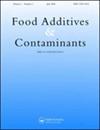Seasonal variations and human health risk assessment of trace elements in the bivalve ecosystem in the Sea of Marmara
IF 2.5
3区 农林科学
Q2 CHEMISTRY, APPLIED
Food additives & contaminants. Part B, Surveillance
Pub Date : 2022-06-16
DOI:10.1080/19393210.2022.2084567
引用次数: 0
Abstract
ABSTRACT Twelve trace elements were studied in four economically important bivalve molluscs (Mediterranean mussel, manila clam, striped venus clam, and truncated wedge clam) from the southern Marmara Sea for seasonal bioaccumulation and human health risk assessment. According to the findings, Fe and Zn were the most accumulative and element concentrations changed considerably (P < 0.05) between seasons and species. Daily, weekly, monthly intake and target hazard quotients of the trace elements were estimated and compared with maximum limits. The results revealed that consuming these bivalve molluscs from the southern Marmara Sea could be considered safe for human consumption. Nevertheless, further monitoring is needed in order to better follow the development in time of elemental pollution due to increasing environmental pressure on the Marmara Sea basin, together with research on other different bioaccumulative organisms.马尔马拉海双壳类生态系统中微量元素的季节变化及人体健康风险评价
摘要对马尔马拉海南部4种具有重要经济价值的双壳类软体动物(地中海贻贝、马尼拉蛤、条纹蛤和楔形蛤)体内12种微量元素进行了季节性生物积累和人体健康风险评价。结果表明,铁和锌的累积量最大,各季节、各物种间元素含量变化显著(P < 0.05)。估计每日、每周、每月微量元素摄入量和目标危害商,并与最大限量进行比较。结果表明,食用这些来自马尔马拉海南部的双壳类软体动物可以被认为是安全的。然而,为了更好地及时跟踪由于马尔马拉海盆地环境压力增加而造成的元素污染的发展,以及对其他不同的生物积累有机体的研究,需要进一步的监测。
本文章由计算机程序翻译,如有差异,请以英文原文为准。
求助全文
约1分钟内获得全文
求助全文
来源期刊
CiteScore
5.30
自引率
10.30%
发文量
37
审稿时长
2.7 months
期刊介绍:
Food Additives & Contaminants: Part B publishes surveillance data indicating the presence and levels of occurrence of designated food additives, residues and contaminants in foods, food supplements and animal feed. Data using validated methods must meet stipulated quality standards to be acceptable and must be presented in a prescribed format for subsequent data-handling.
Food Additives & Contaminants: Part B restricts its scope to include certain classes of food additives, residues and contaminants. This is based on a goal of covering those areas where there is a need to record surveillance data for the purposes of exposure and risk assessment.
The scope is initially restricted to:
Additives - food colours, artificial sweeteners, and preservatives;
Residues – veterinary drug and pesticide residues;
Contaminants – metals, mycotoxins, phycotoxins, plant toxins, nitrate/nitrite, PCDDs/PCFDs, PCBs, PAHs, acrylamide, 3-MPCD and contaminants derived from food packaging.
Readership: The readership includes scientists involved in all aspects of food safety and quality and particularly those involved in monitoring human exposure to chemicals from the diet.
Papers reporting surveillance data in areas other than the above should be submitted to Part A . The scope of Part B will be expanded from time-to-time to ensure inclusion of new areas of concern.

 求助内容:
求助内容: 应助结果提醒方式:
应助结果提醒方式:


